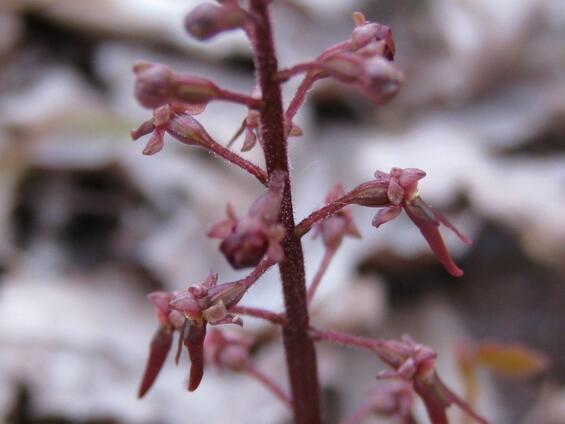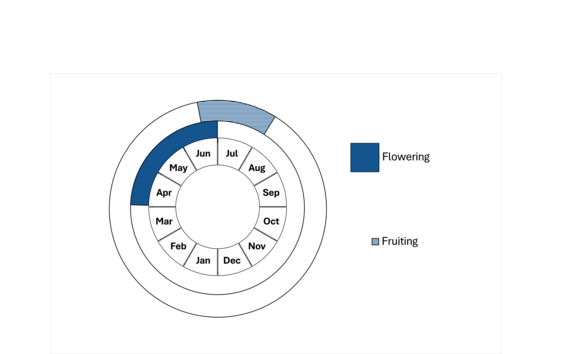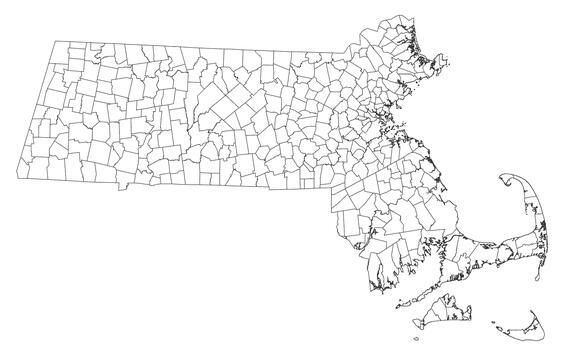- Scientific name: Neottia bifolia (Raf.) Baumbach
- Species of Greatest Conservation Need (MA State Wildlife Action Plan)
- Threatened (MA Endangered Species Act)
Description

Southern twayblade, (Neottia bifolia, syn. Listera australis Lindl.) is a small, up to 25 cm (10 in) tall, herbaceous perennial in the orchid family (Orchidaceae). Plants have two opposite leaves and one flowering stalk with 5 to 25 reddish-purple flowers in a raceme (flowering stem with a main axis and flowers on pedicels or individual stems). The flowering time in Massachusetts is from late April to June in the coastal plain red maple/shrub swamps where it occurs. Pollination is by a variety of flying insects, often by fungus gnats, seeking nectar. As the common name indicates, it has a more southern distribution than other species in the genus. Orchids of this genus are known to have mycorrhizal associates.
Southern twayblade has reddish-purple stems (although a green form of the plant is present in the Massachusetts populations) with two sub-opposite, dark green, ovate leaves, 1.3-4.0 cm (0.5-1.6 in) in length. The axis of the inflorescence (flowering stem) and pedicels (individual flower stems) are glandular-hairy. The small petals are recurved (1.5 mm; 0.06 in). The lip (lower petal of an orchid flower) is 6-12 mm (0.24-0.47 in) and split halfway into two linear lobes with a minute tooth in the sinus between them. The fruiting capsules are 8 mm (0.31 in) long and have a horizontal orientation. Flower parts remain when the plant is in fruit.
Heart-leaf twayblade (Neottia cordata [syn. Listera cordata]), found in coastal plain coniferous swamps, is the only other species in this genus to be found in Massachusetts. It differs from southern twayblade in having pronounced cordate (heart-shape) leaves, a glabrous (no hairs) axis of the inflorescence, flowers slightly larger with the lip split halfway to two-thirds into two linear, spreading lobes, and basal auricles that protrude sideways like horns (see fact sheet for Neottia cordata).
Life cycle and behavior
This is a perennial species.

Population status
Southern twayblade is listed under the Massachusetts Endangered Species Act as threatened. All listed species are protected from killing, collecting, possessing, or sale and from activities that would destroy habitat and thus directly or indirectly cause mortality or disrupt critical behaviors. Only four populations are known in Massachusetts, in Dukes and Bristol Counties. It is considered of conservation concern throughout its range in North America in all but the southernmost US; it has fewer than 300 known occurrences in North America. Although similar habitat is common within the state, because of the small size of the plants, small flowers, and early flowering time, it may be overlooked.

Distribution in Massachusetts
1999-2024
Based on records in the Natural Heritage Database
Distribution and abundance
Southern twayblade is found in scattered locations throughout its range with the closest populations to Massachusetts in Vermont, Long Island, and New Jersey. Populations are found in southern Quebec, Ontario, and Maritime Provinces, where it is considered endangered, south along the eastern coastal plain to Florida and Gulf states to Texas.
Habitat
In Massachusetts, southern twayblade is found growing in deciduous leaf litter in red maple/shrub-dominated swamps. Associated shrubs are typical of coastal plain shrub swamps, and include highbush blueberry (Vaccinium corymbosum), swamp azalea (Rhododendron viscosum), sweet pepperbush (Clethra alnifolia), and inkberry (Ilex glabra). Associated herbaceous species are cinnamon fern (Osmundastrum cinnamomeum), Massachusetts fern (Parathelypteris simulata), Canada mayflower (Maianthemum canadense), sensitive fern (Onoclea sensibilis), and jack-in-the-pulpit (Arisaema triphyllum). In other locations, this species is found in bogs, sedge-shrub fen openings, and forested wetlands on hummocks (above water level), often with sphagnum moss. Recent studies have shown a larger number of individuals are present in areas with less woody canopy cover.
Healthy habitats are vital for supporting native wildlife and plants. Explore habitats and learn about conservation and restoration in Massachusetts.
Threats
Possible threats include browsing, trampling, and development of all kinds. The presence of deer in the vicinity of populations has been observed, but it was not determined whether deer have a negative effect by browsing the orchids, or a positive influence by browsing nearby vegetation and thus providing light openings. Other threats that are typical in Massachusetts wetlands, such as invasive species, changes in hydrology whether from natural or anthropogenic influences, or nearby forest management practices, may have a negative impact on this species and its habitat.
Conservation
As of 2025, three of the four populations are located on protected land; however, monitoring to determine the impacts of deer browsing and competing vegetation should be completed. Potential habitat in Massachusetts is fairly common throughout the coastal plain and searches for additional populations during flowering time when plants are easiest to identify should be done. Assessment of threats should be done on a case-by-case basis. All active management of state-listed plant populations, including invasive species removal, is subject to review under the Massachusetts Endangered Species Act and should be planned in close consultation with the MassWildlife’s Natural Heritage & Endangered Species Program.
References
Hoy, J.M. 2003. Listera australis (Southern Twayblade) Conservation and Research Plan for New England. New England Plant Conservation Program, Framingham, Massachusetts, USA.
Lamont, E.E., J.M. Beitel, and R.E. Zaremba. 1988. Current Status of Orchids on Long Island, New York. Bulletin of the Torrey Botanical Club 115 (2)(April 1): 113–121.
Magrath, L. K., and R. A. Colemen. 2002. Listera. Flora of North America North of Mexico, vol. 26, 586–592. Oxford University Press, New York, NY.
Reddoch, J.M., and A.H. Reddoch. 1997. Special Issue: The Orchids in the Ottawa District : floristics, phytogeography, population studies and historical review. Canadian Field-Naturalist 111(1). Accessed online at: http://ia600604.us.archive.org/29/items/mobot31753003471858/mobot31753003471858.pdf
Contact
| Date published: | May 6, 2025 |
|---|